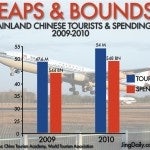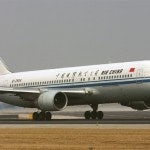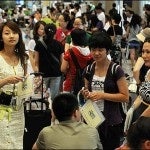Our 10 Favorite Tourism Posts Of The Year#

The Astor Hotel will reopen on May 1.
Starwood To Open First “Luxury Collection” Hotels In China (January 29)
American hotel operator Starwood– which owns brands like Sheraton, Westin, W and St. Regis — has made a big push in the Chinese market in the last decade, particularly in the last few years. In 2010, the company plans to open 30 hotels in China, two of which will be the first “Luxury Collection” hotels in the mainland.
From China Hospitality News:
The iconic Astor Hotel in Tianjin is scheduled to open as a Luxury Collection Hotel in May 2010 after a US$22 million renovation. And The Malus Sanya, a Luxury Collection Resort, is a new-build resort set to open in late 2012 [in Hainan province].

An exclusive tour of the Empire State Building was included.
The Largest-Ever Chinese Tour Group Hits New York, Spends $6 Million (February 18)
Jing Daily has written about the increased outreach efforts of retailers like Macy’s to reach out to Chinese — and other free-spending — tourists in New York. From special discount cards to smaller, but similarly appreciated, gestures like multilingual signs, retailers in major American tourist destinations like New York have recognized the huge opportunity that China’s growing ranks of outbound tourists present and have retooled their marketing appropriately.
The efforts of Macy’s and others were apparent, as China’s largest-ever America-bound tour group (numbering around 1,000) hit New York in a Chinese New Year tour organized by Continental Airlines and the New York Galaxy Travel Agency. According to Chinese media, the activities organized by Macy’s were a hit among members of this large tourist contingent.
Naturally, Chinese online opinion about this group of 1,000 free-spending tourists (who apparently spent an average of $6,000 each, if Xinhua’s estimates are correct) is mixed, with the Jiefang Ribao (Liberation Daily) quoting critical netizens and concluding somewhat cooly, “This tourist trip is just a tourist trip. It proves nothing and it changes nothing. Isn’t it overkill to cheer or criticize it?”

Mainland Chinese visitors will outnumber Japanese for the first time since 1964.
Mainland Chinese Likely To Surpass Japanese As Top Taiwan Visitors For First Time (April 19)
As travel restrictions have eased in recent years, outbound tourism among mainland Chinese has skyrocketed. An estimated 50 million mainland Chinese tourists and businesspeople are expected to venture outward in 2010, up from less than 10 million in 2000. Although many of these 50 million travelers will head to nearby Hong Kong or Macau, or bordering countries like Vietnam or Thailand, more mainland Chinese travelers than ever had their sights set on Taiwan.
In 2009, amid the global financial slowdown that saw the number of non-Chinese tourists to Taiwan plummet, Taiwanese tourism officials began an unprecedented tourism outreach program throughout mainland China, embarking on promotional campaigns in Guizhou and announcing that the first-ever cross-straits tourism offices will open in Taipei and Beijing next month. Along with increased business ties, the administration of Ma Ying-jeou has encouraged more tourism exchange — a move very much welcomed by hotels and tour operators in Taiwan. As Yao Ta-kuang, chairman of the Travel Agent Association of Taiwan, said last year, “[In 2008,] mainland Chinese made 40 million trips abroad. If even just 1 million of them [came] to Taiwan, we could keep the industry going for generations.”

Mainland Chinese Tourists & Spending
Chinese Outspend French To Become World’s #4 Tourism Spenders (April 29)
As spending on outbound tourism by travelers in developed markets like France, Germany, the UK and the US plummeted last year amid the global financial slump, mainland Chinese tourists — the ranks of which have swelled as more middle-class Chinese start to take their first trips abroad — leapfrogged the French to become the world’s fourth-largest tourism spenders.
According to figures released by the United Nations World Tourism Organization this week, Chinese tourists spent a total of $44 billion outside the country last year, a staggering 21% rise over the year before, putting them behind only Germany, the U.S. and the U.K. in international spending.

71% of Chinese business travelers think work-related trips are a necessity.
Poll: 75% Of Chinese Business Travelers Plan More Trips In 2010 (May 18)
Outbound Chinese travelers are undeniably important to the global tourism industry, with numbers swelling from less than 10 million in 2000 to a projected 50 million in 2010. As more people in the U.S. and Europe think twice about splashing out on international tourism and opt for a “staycation,” for many tour operators, hoteliers and retailers around the world the Chinese can’t come quickly enough. Considering some of the stories we’ve seen in the past year about Chinese tourists’ spending habits abroad, that’s no surprise. But there are reasons for this lavish spending that go beyond simply “loving to shop.”
So what about business travel? Since implementing the “Go Out Policy” (走出去, or “Go Global” policy) in 1999, the Chinese government has aggressively promoted outward investment, particularly in the Middle East, Africa and South America. While opinions on China’s role in these regions is a matter of great controversy in the political realm, in terms of business travel it’s seen the number of Chinese business travelers skyrocket in the last 10 years. According to a new poll commissioned by Marriott Hotels & Resorts, not only are these Chinese business travelers overwhelmingly (75%) planning to continue to travel even more in 2010, they’re far more economically optimistic than their counterparts in the U.S., U.K., and Germany.

Club Med
Club Med Looks To Make China Its Second-Largest Market On Heels Of Fosun Investment (June 14)
With domestic tourism — far more affordable for the middle class —expected to remain strong in the long term, some cities and resort towns have invested heavily in tourism infrastructure in recent years. Amid this investment, we’ve begun to see some established international tourism companies look to expand into mainland China in the hopes of tapping the country’s huge potential for domestic tourism both at the lower and high-end price points.
This week, the nearly 60-year-old French tourism specialist Club Mediterranee — better known as Club Med — became the latest of these companies, announcing that the Chinese conglomerate Fosun International had acquired a 7.1% stake in Club Med. According to Club Med, Fosun’s acquisition will help accelerate the rollout of the Club Med concept in China, and the company is projecting that China could become its second-largest market within only five years.

The Italy-based Cruise ship that made its first arrival in Tianjin.
Tianjin To Become Largest Home Port In Asia For Cruise Liners (June 28)
That weekend marked the opening of the Tianjin International Cruise Home Port in the northern Chinese city of Tianjin, which is in the midst of a construction boom aimed at promoting Tianjin as a modern destination for investment and tourism.
Though these efforts haven’t been easy, they have been somewhat successful in attracting high-profile investors like the Singaporean hotel chain Raffles that see great potential in Tianjin’s business travel and tourism markets.
The annual handling capacity of the Tianjin International Cruise Home Port is expected to top 500,000 passengers per year, making it the largest home port in Asia. However, its administrators will have their work cut out for them — river cruise liners are fighting for primacy in south China, and Hainan island looks to become a premier cruise port as part of its luxury makeover in coming years.

Chinese tourists are traveling (and spending) more at home.
China Unveils First Tourism Academy (July 6)
Tourism is big business in China, with domestic and inbound tourism revenues hitting a record $185 billion (1.26 trillion yuan) in 2009 and increased spending by Chinese tourists picking up the slack for more frugal international visitors. And much like other red-hot industries like art or luxury, in tandem with the growth of the tourism market there has been a growing interest among many Chinese students in looking to study fields like tourism development at the few specialized programs offered at universities in China. This week, the newest institution offering a number of dedicated programs in the field of tourism, the Chinese Academy for Tourism Talent Development, opened in Beijing.
A joint venture between the China National Tourism Administration and Beijing International Studies University, the academy’s stated focus is on domestic talent development.

Chinese tourists in the UK are making up for fewer visitors from elsewhere.
Britain Expecting Chinese Tourist Arrivals To Rise 89% By 2014 (September 13)
It’s well established that China’s elite sees Britain as a prime destination for luxury shopping, real estate buying sprees, and even for their children, but as travel restrictions gradually ease, travel to the UK is starting to become attainable for the burgeoning Chinese middle class as well. As a spokesman for VisitBritain — the official site of the British Tourism Authority — told Sky News this week, the lure not only of high-end shopping in London but also Premier League Football, which enjoys extraordinary popularity throughout mainland China, should see upwards of 100,000 more Chinese tourists headed to the UK by 2014. (A rise of 89% over current figures.)

Chinese tourists
Chinese Tourists Heading To South Korea Following Japan Row (October 25)
Following the diplomatic spat that flared up between China and Japan after a Chinese fishing vessel collided with Japanese coast guard ships near a group of island claimed by both nations, the number of Chinese tourists visiting Japan has plummeted, much to the chagrin of tourism authorities and retailers, who previously had projected a record number of Chinese to visit Japan this year. Jing Daily reported that Japanese tourism officials expected an “explosion” of Chinese tourists earlier this year, following the easing of visa restrictions that took effect July 1 and would have brought an estimated 150,000 extra Chinese visitors annually.
However, in the wake of the Senkaku/Diaoyu island clash and resulting protests on both sides of the East China Sea, one thing that has been largely overlooked in the travel industry is that the outbound tourists who had planned to visit Japan this fall still want to go somewhere, and in many cases that “somewhere” has become South Korea.